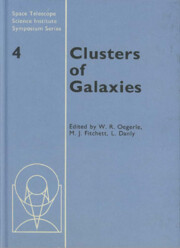Book contents
- Frontmatter
- Contents
- Preface
- Participants
- Chapter 1 Cosmology and Cluster Formation
- Chapter 2 Clusters of Galaxies: Structure, Infall, and Large-Scale Distribution
- Chapter 3 Cosmogony with Clusters of Galaxies
- Chapter 4 Cosmogony and the Structure of Rich Clusters of Galaxies
- Chapter 5 The Dark Matter Distribution in Clusters
- Chapter 6 The Effect of the Cluster Environment on Galaxies
- Chapter 7 Evidence for Gas Deficiency in Cluster Galaxies
- Chapter 8 Properties of Galaxies in Groups and Clusters
- Chapter 9 Dynamical Evolution of Clusters of Galaxies
- Chapter 10 Hot Gas in Clusters of Galaxies
- Chapter 11 Hydrodynamic Simulations of the Intracluster Medium
- Chapter 12 Evolution of Clusters in the Hierarchical Scenario
- Chapter 13 Distant Clusters as Cosmological Laboratories
- Chapter 14 Future Key Optical Observations of Galaxy Clusters
- Chapter 15 Cluster Research with X-ray Observations
- Plate section
Preface
Published online by Cambridge University Press: 06 July 2010
- Frontmatter
- Contents
- Preface
- Participants
- Chapter 1 Cosmology and Cluster Formation
- Chapter 2 Clusters of Galaxies: Structure, Infall, and Large-Scale Distribution
- Chapter 3 Cosmogony with Clusters of Galaxies
- Chapter 4 Cosmogony and the Structure of Rich Clusters of Galaxies
- Chapter 5 The Dark Matter Distribution in Clusters
- Chapter 6 The Effect of the Cluster Environment on Galaxies
- Chapter 7 Evidence for Gas Deficiency in Cluster Galaxies
- Chapter 8 Properties of Galaxies in Groups and Clusters
- Chapter 9 Dynamical Evolution of Clusters of Galaxies
- Chapter 10 Hot Gas in Clusters of Galaxies
- Chapter 11 Hydrodynamic Simulations of the Intracluster Medium
- Chapter 12 Evolution of Clusters in the Hierarchical Scenario
- Chapter 13 Distant Clusters as Cosmological Laboratories
- Chapter 14 Future Key Optical Observations of Galaxy Clusters
- Chapter 15 Cluster Research with X-ray Observations
- Plate section
Summary
Clusters of galaxies are probably the largest gravitationally bound entities in the universe. They offer a laboratory for studying such diverse astrophysical problems as the form of the initial fluctuation spectrum, the evolution and formation of galaxies, environmental effects on galaxies, and the nature and quantity of dark matter in the universe, as well as providing tracers of the large-scale structure. The view that clusters are dynamically relaxed systems has been challenged by the demonstration of significant substructure in the galaxy and X-ray distribution within clusters (see the chapters herein by Geller, Cavaliere & Colafrancesco, Fitchett, Richstone, and Forman). There is, however, still some dissent on the reality of subclustering (see the discussion in West's chapter). New simulations of the formation and evolution of the dark matter and gas distributions in clusters are giving interesting results—their confrontation with observations may yield information on the nature of the initial density fluctuations required to form galaxies and enable us to solve some of the problems in this field (e.g., the so-called “β–discrepancy”). The simulations should also allow for better comparisons between theory and optical and X-ray observations (see the chapters by Cavaliere & Colafrancesco, Evrard and West). The abundance and velocity dispersions of rich clusters, and measurements of their clustering properties and peculiar motions may provide strong constraints on theories of galaxy formation (see the chapters by Kaiser, Peebles and West).
- Type
- Chapter
- Information
- Clusters of Galaxies , pp. xi - xiiPublisher: Cambridge University PressPrint publication year: 1990



